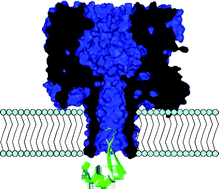Squeezing a single polypeptide through a nanopore
Abstract
We have already seen a decade of single-molecule science involving

* Corresponding authors
a
Department of Physics, Syracuse University, 201 Physics Building, Syracuse, New York 13244-1130, USA
E-mail:
lmovilea@physics.syr.edu
Fax: +315-443-9103
Tel: +315-443-8078
b Structural Biology, Biochemistry and Biophysics Program, Syracuse University, 111 College Place, Syracuse, New York 13244-4100, USA
We have already seen a decade of single-molecule science involving

 Please wait while we load your content...
Something went wrong. Try again?
Please wait while we load your content...
Something went wrong. Try again?
L. Movileanu, Soft Matter, 2008, 4, 925 DOI: 10.1039/B719850G
To request permission to reproduce material from this article, please go to the Copyright Clearance Center request page.
If you are an author contributing to an RSC publication, you do not need to request permission provided correct acknowledgement is given.
If you are the author of this article, you do not need to request permission to reproduce figures and diagrams provided correct acknowledgement is given. If you want to reproduce the whole article in a third-party publication (excluding your thesis/dissertation for which permission is not required) please go to the Copyright Clearance Center request page.
Read more about how to correctly acknowledge RSC content.
 Fetching data from CrossRef.
Fetching data from CrossRef.
This may take some time to load.
Loading related content
